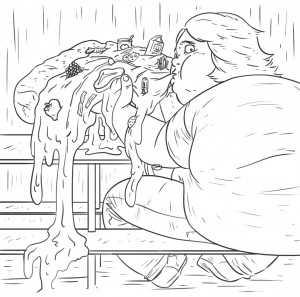This year has been quite a newsworthy one, with events around the globe rousing the public and inspiring a slew of intriguing headlines. But a few weeks ago, one headline in particular really shook Americans: “Pizza a Vegetable? Congress Says Yes.”

Some found this news ridiculously amusing; others were outraged. But everyone can take a deep breath — Congress did not actuallydeclare pizza a vegetable. They did, however, say that two tablespoons of tomato sauce on pizzas served in school cafeterias count as a serving of vegetables. It’s a theoretical and mathematical question, really. According to Congress, two tablespoons of tomato paste has as much nutritional value as half a cup of vegetables.
Childhood obesity is on the rise, and the statistics are alarming: nearly one in three children in America is overweight or obese, according to the Centers for Disease Control and Prevention. And since children consume roughly 40 percent of their daily calories during lunch at school, it makes sense for the government to choose school lunches as the battle grounds against childhood obesity. In February 2010, First Lady Michelle Obama launched her “Let’s Move!” campaign, which focuses on educating children and parents about nutrition. At the same time, her husband established the Task Force on Childhood Obesity, with the goal of reducing the nation’s childhood obesity rate to 5 percent — the rate of childhood obesity before it began to rise in the late 1970s. Clearly, the Obamas have made it a priority to educate the public about nutrition and make America a healthier country.
But not everyone wants to combat childhood obesity — in fact, the food industry is doing everything it can to keep nutritionally poor foods on school lunch menus.
In early November, the U.S. Department of Agriculture’s proposal to overhaul the nation’s school lunch program went before Congress. The USDA wanted to limit starchy vegetables, such as corn and potatoes, to one cup per-student per-week, in the hopes of getting children to try new vegetables like spinach and collard greens. The proposal also said that two tablespoons of tomato sauce wouldn’t be enough to count as a serving of vegetables — the amount would have to be at least half a cup, or eight tablespoons. Ultimately, the USDA’s proposal sought to include more fruits, green vegetables and whole grains to school lunch programs. But according to a November 1 article in *The New York Times*, food companies spent more than $5.6 million lobbying against the USDA’s proposal — apparently, the proposed changes were too radical and posed a direct threat to the food industry. In the end, Congress caved in to the lobbyists and blocked the proposal.
Why does the food industry want to make us even fatter? Well, for starters, there’s a lot of money to be made in school lunches. About 32 million children receive subsidized or free lunches in the National School Lunch Program. And come on, it’s a known fact that kids don’t like vegetables. In fact, the USDA reported in 2007 that pizza and french fries are among the most commonly consumed lunch foods in the National School Lunch Program. The American Frozen Food Institute, then, is not only lobbying on behalf of food companies like Schwan’s Food Service Inc., which supplies frozen pizzas to 75 percent of schools in the U.S. — it’s also lobbying on behalf of children. Isn’t it their birthright to enjoy delicious, highly processed foods? Besides, drenching pizza in half a cup of tomato sauce, per the USDA’s healthy lunch proposal, would make it “unpalatable” to children, argued the AFFI. And potatoes are a legitimate source of carbohydrates (never mind the fact that most of the potatoes served in schools are first frozen and then deep-fried, a process that adds both calories and trans fat). The fact is, the food industry thinks of profit first, health second.
Really, though, we shouldn’t be feeding french fries and pizza to kids — even if they are comforting and tasty. Foods like these are highly processed and provide little nutritional value. And with their high concentration of sodium and trans fat, they can contribute to weight gain. We cannot fight childhood obesity unless we start feeding our children fresher and more wholesome foods. Since children eat a good proportion of their daily calories at school, and school influences how kids mature, learn, and ultimately view the world, it seems like a good place to start educating them about nutrition. The National School Lunch Program shouldn’t just aim to feed children, but to make them healthier, to teach them about food so they can make informed decisions about what to put in their mouths.
The government, and the Obama administration in particular, has been quite vocal about childhood obesity and the nation’s health. But while Michelle Obama plants fresh fruit and vegetables in the White House garden, Congress is yielding to lobbyists — and as a result, most kids in America are continuing to eat unhealthy school lunches. Unless lawmakers start standing up to big business, it seems likely that this unfortunate trend will continue. The next shocking headline? My guess: “Two Scoops of Ice Cream Equivalent to a Glass of Milk, Says Congress.”







Leave a Reply